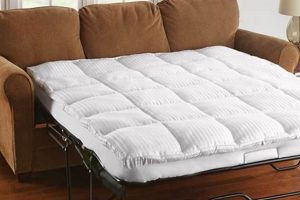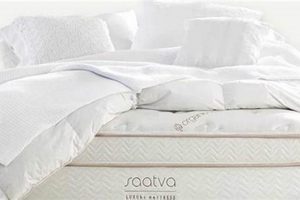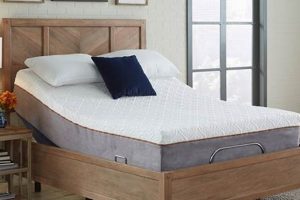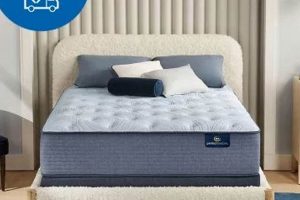The selection of an appropriate sleep surface is paramount for individuals who primarily adopt a prone sleeping position. This type of product is engineered to provide a specific level of support and comfort, accommodating the unique pressure points and spinal alignment requirements associated with stomach sleeping. These mattresses differ significantly from those designed for back or side sleepers, emphasizing firmness and minimizing sinkage in the midsection.
Optimal spinal alignment is crucial for preventing discomfort and potential long-term musculoskeletal issues. A well-designed sleep surface for stomach sleepers mitigates hyperextension of the spine and reduces pressure on the neck and shoulders. Furthermore, a suitable mattress can contribute to improved breathing and reduced snoring by maintaining an open airway. The development and refinement of these products have evolved alongside sleep science, incorporating advances in materials and construction techniques to enhance sleep quality.
Therefore, understanding the key characteristics and materials is essential for consumers seeking the most suitable sleep surface. Considerations include factors such as firmness level, construction materials (e.g., innerspring, memory foam, hybrid), and features like edge support and breathability. Examining these elements will provide a clearer picture of how to choose a sleep surface that best aligns with individual needs and preferences.
Guidance for Stomach Sleepers
Selecting the correct sleep surface involves careful consideration. The following guidelines are designed to assist individuals who primarily sleep in a prone position in making an informed decision.
Tip 1: Prioritize Firmness. A firmer surface is generally recommended to prevent excessive sinking of the hips and abdomen. This helps maintain spinal alignment and reduces the risk of lower back pain.
Tip 2: Consider Hybrid or Innerspring Construction. These types often provide better support for stomach sleepers due to their responsive coil systems. Look for models with reinforced edges to prevent sagging and ensure consistent support across the entire surface.
Tip 3: Minimize Memory Foam Thickness. While memory foam can offer comfort, excessive layers may lead to increased sinkage and potential spinal misalignment. If memory foam is desired, opt for a thinner comfort layer over a supportive core.
Tip 4: Evaluate Breathability. Stomach sleepers often experience higher body temperatures due to increased contact with the sleep surface. Look for models with features such as breathable covers or open-cell foam to promote airflow and regulate temperature.
Tip 5: Research Edge Support. Strong edge support is essential for utilizing the entire surface area of the sleep surface, particularly for individuals who tend to sleep close to the edge. This feature also contributes to overall stability and durability.
Tip 6: Assess Spinal Alignment. Regardless of the materials or construction, proper spinal alignment is the ultimate goal. Consider trying out the prospective purchase in-store, if possible, or opting for a model with a trial period to ensure it provides adequate support and comfort.
Tip 7: Pillow Selection Matters. A thin or no pillow may be preferable to avoid neck strain. The goal is to maintain a neutral spinal position, even while sleeping in a prone posture.
Selecting an appropriate sleep surface necessitates careful research and consideration. Focusing on the factors outlined above can significantly enhance sleep quality and minimize the risk of discomfort or musculoskeletal issues.
Ultimately, the right sleep surface is a highly personal choice. By focusing on the factors discussed, individuals who favor the prone sleeping position can increase their chances of finding a mattress that promotes restful and restorative sleep.
1. Firmness Level
Firmness level represents a critical determinant in selecting a sleep surface optimized for prone sleepers. Insufficient firmness results in excessive sinking of the hips and abdomen, causing spinal misalignment. This misalignment can lead to lower back pain and discomfort. Conversely, a surface that is too firm may create pressure points, particularly in the ribcage and hip area, also contributing to discomfort. The ideal firmness level for a prone sleeper seeks to maintain a relatively straight spinal alignment, preventing both excessive curvature and undue pressure.
The influence of firmness extends beyond immediate comfort. Prolonged spinal misalignment, even during sleep, can contribute to chronic musculoskeletal issues. A correctly chosen mattress mitigates this risk, promoting healthy posture and reducing the likelihood of developing long-term pain. For instance, individuals with a higher body mass typically require a firmer surface to maintain proper support, whereas those with a lighter frame may find a medium-firm option more suitable. Mattress manufacturers often provide firmness ratings to guide consumers, but individual preferences and body types should be carefully considered during the selection process.
Therefore, understanding the impact of firmness is paramount for prone sleepers. While specific firmness preferences vary, the underlying principle remains consistent: maintaining spinal alignment to minimize discomfort and prevent long-term musculoskeletal problems. Choosing the correct firmness level is not merely about comfort; it is about investing in long-term health and well-being. Selecting the appropriate firmness is essential for identifying the most suitable sleep surface for a prone sleeper.
2. Spinal Alignment
Spinal alignment is a fundamental consideration when selecting a sleep surface, particularly for stomach sleepers. The prone sleeping position inherently places stress on the spine, necessitating a surface that mitigates this strain and promotes a neutral spinal posture. Optimizing spinal alignment during sleep can reduce the risk of musculoskeletal discomfort and contribute to improved overall health.
- Neutral Spinal Posture
Achieving a neutral spinal posture involves maintaining the natural curvature of the spine, preventing excessive arching or flattening. A suitable sleep surface prevents the abdomen from sinking too deeply, which can hyperextend the lower back. Conversely, the surface must not be too firm, as this can create pressure points and force the spine out of alignment. The goal is to provide consistent support that conforms to the body’s contours without compromising the spine’s natural shape.
- Pressure Distribution
Proper spinal alignment ensures equitable pressure distribution along the length of the spine. This prevents localized stress concentrations that can lead to pain and discomfort. A well-designed surface distributes weight evenly, reducing pressure on the hips, shoulders, and ribcage. Uneven pressure distribution can exacerbate existing musculoskeletal issues and contribute to the development of new problems. A surface that promotes spinal alignment effectively manages pressure distribution, enhancing comfort and minimizing the risk of pain.
- Muscle Relaxation
When the spine is properly aligned, the surrounding muscles can relax fully. Misalignment forces muscles to compensate, leading to tension and fatigue. A sleep surface that supports spinal alignment allows muscles to release tension, promoting restful sleep and reducing the likelihood of morning stiffness. Muscle relaxation is essential for recovery and regeneration, and it is directly influenced by the support provided by the sleeping surface.
- Long-Term Health Implications
Chronic spinal misalignment, even during sleep, can have significant long-term health implications. It can contribute to degenerative disc disease, sciatica, and other musculoskeletal disorders. Selecting a sleep surface that prioritizes spinal alignment is an investment in long-term health. By maintaining a neutral spinal posture, individuals can mitigate the risk of developing chronic pain and improve their overall quality of life. The benefits of proper spinal alignment extend beyond immediate comfort, impacting long-term well-being.
These facets emphasize that spinal alignment is not merely a comfort consideration, but a crucial factor in preventing musculoskeletal problems and promoting restful sleep. Prioritizing spinal alignment when choosing a sleep surface is essential for individuals who sleep in a prone position, as this sleeping posture inherently places additional stress on the spine. A mattress that effectively supports spinal alignment is a key component of a healthy sleep environment.
3. Material Composition
The selection of materials in a sleep surface significantly impacts its suitability for stomach sleepers. The composition directly influences firmness, support, temperature regulation, and durability, all of which are crucial for optimizing sleep quality and spinal alignment in this position.
- Foam Density and Type
Higher-density foams, such as those found in the support core, offer greater resistance to compression, preventing excessive sinkage in the midsection. This is particularly important for maintaining spinal alignment. Memory foam, while providing pressure relief, may retain heat; therefore, open-cell or gel-infused memory foam can mitigate this issue. The specific blend of foam types determines the overall firmness and comfort level of the sleep surface, influencing its ability to support the stomach sleeper effectively. For example, a high-density polyfoam core with a thinner layer of gel-infused memory foam can provide a balance of support and temperature regulation.
- Innerspring Coil Systems
Innerspring mattresses utilize coil systems to provide support and responsiveness. The gauge and configuration of the coils determine the firmness and stability of the surface. Pocketed coils, where each coil is individually wrapped, minimize motion transfer and conform more closely to the body’s contours. For stomach sleepers, a robust innerspring system with a higher coil count and firmer gauge can offer the necessary support to prevent spinal misalignment. The design of the coil system is paramount in providing consistent and reliable support throughout the sleep duration.
- Hybrid Constructions
Hybrid mattresses combine foam and innerspring components, aiming to provide the benefits of both materials. These constructions typically feature a coil support system overlaid with layers of foam for comfort and pressure relief. The effectiveness of a hybrid mattress for stomach sleepers depends on the specific combination of materials and their arrangement. A well-designed hybrid will prioritize the supportive qualities of the innerspring system while incorporating foam layers that enhance comfort without compromising spinal alignment. The layering and integration of these materials are crucial to achieving the desired balance.
- Cover Materials
The cover material directly influences the sleep surface’s breathability and surface feel. Materials like cotton, bamboo, and Tencel are known for their moisture-wicking properties and ability to promote airflow. This is especially important for stomach sleepers, who often experience greater body contact with the mattress. A breathable cover can help regulate temperature and prevent overheating, contributing to a more comfortable sleep environment. The choice of cover material impacts the overall comfort and temperature regulation of the mattress.
The interplay between these materials dictates the performance of a sleep surface for stomach sleepers. Selecting a mattress with a composition that prioritizes support, temperature regulation, and durability is essential for achieving optimal spinal alignment and a restful sleep experience. The careful consideration of material types and their arrangement is key to finding a suitable sleep surface.
4. Edge Support
Edge support is a critical factor in determining the suitability of a sleep surface, particularly for individuals who favor the prone sleeping position. The stability and reinforcement of the sleep surface’s perimeter directly impact its usable surface area and overall supportiveness, thereby influencing spinal alignment and sleep quality.
- Enhanced Usable Surface Area
Robust edge support maximizes the sleep surface area, allowing individuals to fully utilize the mattress without experiencing a roll-off sensation. This is particularly beneficial for stomach sleepers who may spread out during sleep or shift positions throughout the night. A reinforced edge prevents compression and sagging, ensuring consistent support from edge to edge and allowing for greater freedom of movement.
- Improved Stability and Durability
Strong edge support contributes to the overall structural integrity and longevity of the sleep surface. Mattresses with reinforced edges are less prone to sagging and deformation over time, maintaining their shape and supportiveness. This is especially important for stomach sleepers, who exert concentrated pressure on specific areas of the mattress. Enhanced stability translates to increased durability and a longer lifespan for the product.
- Facilitated Entry and Exit
Reinforced edges provide a stable and supportive perimeter for sitting and standing up from the sleep surface. This is particularly useful for individuals with mobility limitations or those who frequently get in and out of bed. Strong edge support facilitates easier entry and exit, reducing the risk of falls and enhancing overall safety. A stable edge provides a firm foundation for these transitional movements.
- Enhanced Spinal Alignment
Consistent edge support helps maintain proper spinal alignment, even when sleeping near the edge of the sleep surface. By preventing excessive compression and sagging, the reinforced perimeter ensures that the spine remains in a neutral position, reducing the risk of lower back pain and discomfort. This is crucial for stomach sleepers, who require consistent support to maintain healthy spinal posture throughout the night. The stability of the edge contributes to the overall spinal support of the sleep surface.
The integration of robust edge support mechanisms is essential for delivering optimal performance. The consistent support offered by a reinforced perimeter contributes significantly to achieving restful sleep. Therefore, evaluating the edge support features is a critical step in choosing the most suitable sleep surface.
5. Temperature Regulation
Temperature regulation represents a crucial aspect of sleep surface design, particularly for those who favor prone sleeping positions. The close contact between the body and the mattress in this posture can impede airflow, leading to increased body temperature and potential sleep disturbances. Effective temperature regulation mitigates these issues, creating a more comfortable and conducive sleep environment. Material selection, construction techniques, and design features each play a significant role in managing heat and moisture.
The relationship between mattress design and temperature regulation is evidenced by the increasing prevalence of cooling technologies in sleep surfaces. Open-cell foam structures allow for greater airflow compared to traditional memory foam, reducing heat retention. Gel-infused materials and phase-change technology further enhance cooling by absorbing and dissipating heat. Consider, for example, two individuals who both sleep on foam mattresses; the individual on a mattress with open-cell foam and a breathable cover is likely to experience a cooler sleep than the other. This demonstrates the practical impact of temperature-regulating features on sleep comfort.
In summary, temperature regulation is an essential performance criterion. Mattresses incorporating breathable materials, strategic airflow channels, and innovative cooling technologies offer demonstrable benefits to the comfort and quality of sleep for prone sleepers. Addressing this aspect of sleep surface design is critical for maximizing restfulness.
6. Durability
The longevity of a sleep surface constitutes a fundamental consideration, particularly when evaluating its suitability for stomach sleepers. A prone sleeping position often concentrates weight in the midsection, potentially accelerating wear and tear. Consequently, the durability of a mattress directly impacts its ability to maintain proper support and spinal alignment over an extended period. Reduced firmness, sagging, and material degradation can all result from inadequate durability, leading to compromised sleep quality and potential musculoskeletal issues. For example, a mattress with weak edge support may quickly lose its structural integrity under the concentrated pressure exerted by a stomach sleeper, resulting in a sloped sleeping surface and improper spinal alignment.
Material selection, construction techniques, and usage patterns significantly influence mattress durability. Higher-density foams, robust coil systems, and reinforced edges contribute to greater resistance to compression and deformation. Proper maintenance, such as regular rotation and the use of a protective mattress cover, can further extend the lifespan of the product. Conversely, exposure to excessive moisture, direct sunlight, or improper weight distribution can accelerate material degradation and reduce durability. To illustrate, a mattress exposed to frequent spills without adequate protection may experience premature breakdown of its internal components, ultimately diminishing its supportiveness and comfort.
Therefore, durability is not merely a matter of cost-effectiveness but a critical component of long-term sleep health for prone sleepers. A mattress that maintains its structural integrity and support characteristics over time provides consistent spinal alignment, reducing the risk of discomfort and potential musculoskeletal problems. Prioritizing durability through informed material selection, proper maintenance, and consideration of usage patterns is essential for maximizing the value and health benefits of a sleep surface. A durable mattress represents a sustained investment in quality sleep and overall well-being.
Frequently Asked Questions
The following addresses common inquiries regarding the selection and use of mattresses designed to accommodate the prone sleeping position.
Question 1: What firmness level is generally recommended for a stomach sleeper?
A firmer mattress is typically advisable to prevent excessive sinking of the hips and abdomen. This aids in maintaining spinal alignment and reducing the risk of lower back pain. However, individual preferences and body weight should also be considered.
Question 2: Are memory foam mattresses suitable for stomach sleepers?
While memory foam can offer pressure relief, excessive layers may lead to spinal misalignment. If a memory foam mattress is desired, opting for a thinner comfort layer over a supportive core is recommended.
Question 3: What type of mattress construction is best for stomach sleepers?
Hybrid or innerspring mattresses often provide better support due to their responsive coil systems. These types offer enhanced firmness and prevent excessive sinkage. Models with reinforced edges are also beneficial.
Question 4: How important is edge support for a stomach sleeper?
Strong edge support is essential for utilizing the entire surface area of the mattress and preventing a roll-off sensation. It also contributes to overall stability and durability, particularly for those who sleep near the edge.
Question 5: What role does a pillow play in spinal alignment for stomach sleepers?
A thin or no pillow may be preferable to avoid neck strain and maintain a neutral spinal position. The goal is to minimize neck flexion and ensure the head is aligned with the spine.
Question 6: How can temperature regulation be improved in a mattress for stomach sleepers?
Selecting models with breathable covers or open-cell foam can promote airflow and regulate temperature. These features help mitigate heat retention, which can be problematic for stomach sleepers due to increased body contact with the sleep surface.
Careful consideration of these factors can significantly enhance sleep quality and minimize the risk of discomfort for stomach sleepers.
The next section will delve into specific mattress recommendations based on varying needs and preferences.
In Summary
The foregoing analysis underscores the multifaceted nature of selecting the most appropriate sleep surface for prone sleepers. Firmness, spinal alignment, material composition, edge support, temperature regulation, and durability each play a critical role in ensuring optimal comfort and minimizing potential musculoskeletal issues. The best choice necessitates a careful evaluation of these interacting elements to address individual needs and preferences.
Ultimately, prioritizing these factors is essential for long-term sleep health and overall well-being. Continued advancements in sleep surface technology promise further improvements in comfort and support, potentially mitigating the inherent challenges associated with the prone sleeping position. Staying informed and making considered purchasing decisions remains paramount.







